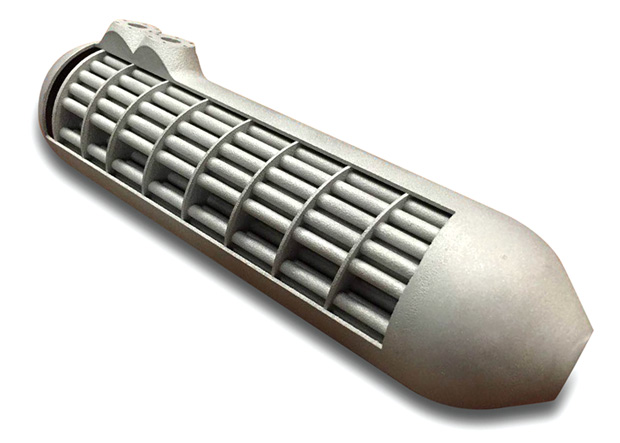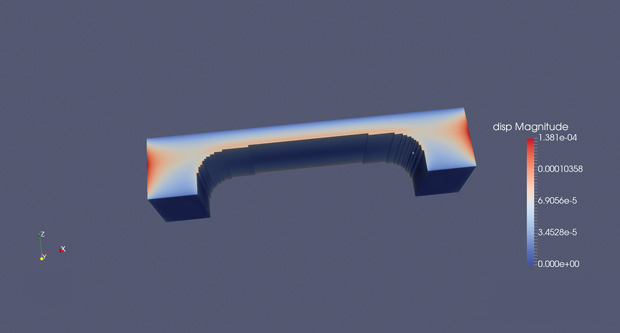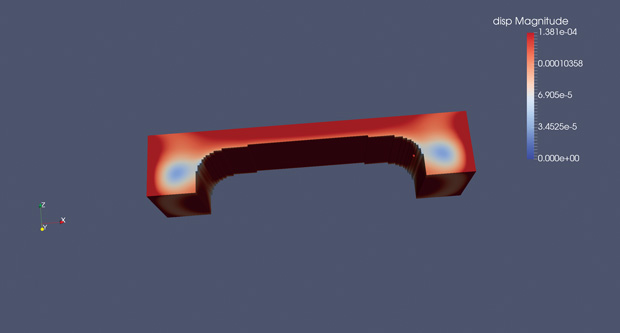The Changing Art of Making Parts: Part 2

If this heat exchanger was manufactured by conventional methods, it would comprise an assembly of over 100 individually manufactured components. By making some minor additive manufacturing design changes and utilizing the EOS M290 direct metal laser sintering machine, the heat exchanger assembly was 3D printed as a single component. Image courtesy of University of Pittsburgh.
Latest News
January 3, 2017
Editor’s Note: Read part 1 of this article, which appeared in the December 2016 issue.
What is one of the greatest challenges in additive manufacturing (AM)? The ability to model and predict the performance characteristics of the new materials being used in AM. Here, simulation software tools can be of significant value. There are a number of key areas where simulation can play an important role in 3D printing, such as generating a functional design, generating lattice structures, calibrating the material, optimizing the manufacturing process and in-service performance.
 If this heat exchanger was manufactured by conventional methods, it would comprise an assembly of over 100 individually manufactured components. By making some minor additive manufacturing design changes and utilizing the EOS M290 direct metal laser sintering machine, the heat exchanger assembly was 3D printed as a single component. Image courtesy of University of Pittsburgh.
If this heat exchanger was manufactured by conventional methods, it would comprise an assembly of over 100 individually manufactured components. By making some minor additive manufacturing design changes and utilizing the EOS M290 direct metal laser sintering machine, the heat exchanger assembly was 3D printed as a single component. Image courtesy of University of Pittsburgh.In particular, a critical aspect of any AM process is to be able to characterize the underlying material that is being used. Typically, with metal alloys for example, a high-intensity laser is applied to a powder bed along a CAD-software-guided path, fusing the metal layer-by-layer to build the part. The metal melts locally and, as the heat-source moves on, solidifies with the previous layer to create the fused part. The phase transformations, the cooling rates, and other machine-specific parameters, such as print speed, guide the metallurgy and the micro-structures that develop.
Such parts can be stronger than those made with traditional manufacturing methods such as casting, but the variabilities in mechanical properties can be significant. Therefore, there is a need to capture the multi-scale and multiphysics nature of the manufacturing process. Here, software such as Dassault Systèmes SIMULIA Abaqus user-subroutine framework can be used to aid researchers and industry to model the physics of the micro-mechanics behavior while leveraging Abaqus as the global solver for the macro-behavior of the parts.
Siemens PLM Software has tackled the AM-simulation challenge with convergent modeling and topology optimization. Convergent modeling is meant to help engineers optimize a part design for 3D printing, speed up the overall design process and provide scan-to-print functionality to make reverse engineering more efficient. Topology optimization helps analysts automate the iterative process for designing and optimizing parts for multiphysics performance including vibration, fluid dynamics and heat transfer. Together, these integrated simulation and predictive engineering analytics capabilities help evaluate the design for manufacturability and provide the confidence needed to qualify designs optimized for additive manufacturing.
Altair, one of the market leaders in topology optimization, also offers several useful tools for tackling AM-simulation, including OptiStruct as well as Inspire from solidThinking, an Altair company. Altair has also partnered with Materialise to offer its 3-matic tool for design modification and remeshing, allowing users to redesign CAD, scanned or topology-optimized data for 3D printing.
ANSYS has also made moves to address the simulation challenges associated with additive manufacturing. Earlier this year, ANSYS forged a partnership with the University of Pittsburgh (Pitt) to solve some of the industry’s toughest additive manufacturing problems, and has established an innovation center in Pittsburgh with the stated goal of pushing the boundaries of additive manufacturing.
3D printing metal is particularly challenging because it typically involves the use of a laser. While the laser optimizes the density of the metal for the particular application, it can also melt the metal in unexpected ways, causing the product to fail. And the rapid heating and cooling causes stresses that can deform the end product. To address this issue, ANSYS and Pitt are working together to simulate those deformations before printing to ensure that the product not only has the desired shape, but also performs as expected.
 Simulation of metal part distortion after the part was additively built, accounting for support structures. Image courtesy of 3DSIM.
Simulation of metal part distortion after the part was additively built, accounting for support structures. Image courtesy of 3DSIM.As part of the partnership, the university is also opening a 1,200-sq.-ft. additive manufacturing lab in the Swanson School of Engineering. The ANSYS Additive Manufacturing Research Laboratory is equipped with some of the most advanced additive manufacturing devices that use metals, alloys, polymers and other materials to laser print components for nearly every industry.
The partnership will also support faculty and students conducting collaborative research with ANSYS and other industry partners, including those in the biomedical, aerospace and defense industries. Lab workers will have access to the ANSYS portfolio, enabling them to explore, simulate and analyze solutions for stress and fatigue on critical components that go into products such as airplanes, cars and medical devices.
While additive manufacturing allows for precise control in creating a component at the micro- and nano-scale level (see Microfabrica: Mass Production at a Millimeter Scale), new processes and software are required to help engineers develop parts that are designed to perform a desired function under a set of conditions. Simulation-driven product development changes the process by virtually exploring the properties of a number of design options early on, before committing to specific material and design choices. The benefit of such physics-based computational tools is that they can test millions of permutations of designs, materials, flows and shapes to find the optimal design before the engineer needs to build a single physical prototype. Not only does this new approach promise to unleash the next wave of innovative physical products, but it is a necessity to make designs more energy-efficient and sustainable.
The Need for Repeatability
What we don’t know is how to effectively represent AM’s multi-scale geometry in a CAD environment or how to efficiently optimize the multi-scale features of 3D printing materials, according to Dr. Brent Stucker, DFAM (Design for Additive Manufacturing) expert and co-founder of the company 3DSIM. Developers also struggle with how to efficiently simulate the link between AM process parameters and microstructures, and how to efficiently compute the effects of changes in microstructures on part performance.
Indeed, because additive manufacturing is still an evolving science, and because so many different approaches and materials are now being used to deliver specific design objectives, it is difficult to consistently achieve the kind of repeatability, reproducibility and quality (e.g. accuracy, surface finish, porosity, mechanical properties) necessary to qualify AM as a vehicle for delivering commercial-grade products, rather than just prototypes. In short, while the focus in a prototyping environment is on flexibility and short delivery times, the focus in a manufacturing process is on repeatability and traceability.
 Simulation of AM metal part distortion, after support removal. Both simulations performed with exaSIM software from 3DSIM. Image courtesy of 3DSIM.
Simulation of AM metal part distortion, after support removal. Both simulations performed with exaSIM software from 3DSIM. Image courtesy of 3DSIM.According to Stucker, the ability to successfully deliver innovative AM offerings has largely been a matter of trial and error, thanks to limited process control, evolving materials and a lack of established standards. Barriers like these introduce considerable uncertainty into AM processes, he says, and companies waste a considerable amount of time and money with failed builds on the journey to perfecting a part. To address these challenges, 3DSIM developed ExaSIM, a cloud-based AM simulation tool that is used to predict how metal-powder-bed AM machines will work by allowing its users to experiment virtually with different materials, processes, build setups and parameters—and predict their outcomes. “It’s going to make it possible to qualify, certify and bring to market products from AM much more quickly,” Stucker says.
Actual 3D printing speed is also an issue—in spite of claims that many of these manufacturers make regarding their 3D printing processes being “X-times faster” than their competitors. (It can, for example, take days for certain types of 3D metal-printing to deliver a finished part.) That said, industrial-strength 3D printers are increasingly finding their way into production in automotive, aerospace and the medical industry where they are showing promising results. In June 2016, for example, Airbus announced that it would be deploying Dassault Systèmes’ collaborative design and simulation applications for the additive manufacturing of tooling, prototyping and parts for test flights and for production use on commercial aircraft.
Streamlining the CAD-to-Print Process
And then there are the design tools. Both the CAD/PLM providers and the AM manufacturers are eager to help make the transition to additive manufacturing as seamless as possible. We are beginning to see capabilities—both within 3D design software and AM tools—that promise to help streamline the hand-off from design to manufacturing. Many of these developers are on a quest to deliver a robust “print preview” for 3D parts that would enable engineers and designers to better evaluate not only the appearance, but also the quality and performance of a 3D printed part prior to manufacture.
For example, Autodesk’s Inventor 2016 + Fusion 360 is equipped with a tool called 3D Print Studio; SOLIDWORKS 2016 offers its Print 3D Property Manager; Stratasys (through its acquisition of GrabCAD) enables users to print parts directly from the CAD file with GrabCAD Print; and 3D Systems’ recently announced partnership with PTC leverages 3D Systems’ 3DXpert metal printing software to provide PTC Creo users with direct CAD-to-print functionality for metals-based AM.
The reality is that we are on the brink of a major market disruptor—the mass adoption of additive manufacturing as a complement to traditional manufacturing methods. That’s because being able to fabricate complex medical-grade and industrial-grade metal or plastic parts using an additive manufacturing process is more convenient, more versatile and more cost-effective than traditional manufacturing approaches in some situations.
Indeed, today’s advanced additive manufacturing (AM) processes, coupled with innovative new AM tools and equipment, and a growing assortment of new materials—from strong metal alloys and specially-engineered polymers to bio-materials—promise to create a whole new class of manufactured goods and services, alongside a whole new ecosystem of customers and suppliers. However, there is still a great deal of work to be done to achieve the Holy Grail of AM: mass customization using on-demand custom materials.
More Info
Subscribe to our FREE magazine, FREE email newsletters or both!
Latest News






